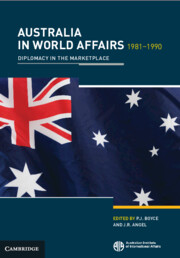Book contents
- Frontmatter
- Contents
- Preface
- Introduction
- Part 1 Australia and the World
- Part 2 Australia and the Regions
- 7 Australia and the United States
- 8 Australia and Southeast Asia
- 9 Australia and the South Pacific
- 10 Australia and the United Kingdom
- 11 Australia and Western Europe
- 12 Australia and the Eastern Bloc
- 13 Australia’s relations with Japan and the Korean Peninsula
- 14 Australia and China
- 15 The Commonwealth connection: a contemporary history and prospect
- Index
15 - The Commonwealth connection: a contemporary history and prospect
from Part 2 - Australia and the Regions
Published online by Cambridge University Press: 29 March 2024
- Frontmatter
- Contents
- Preface
- Introduction
- Part 1 Australia and the World
- Part 2 Australia and the Regions
- 7 Australia and the United States
- 8 Australia and Southeast Asia
- 9 Australia and the South Pacific
- 10 Australia and the United Kingdom
- 11 Australia and Western Europe
- 12 Australia and the Eastern Bloc
- 13 Australia’s relations with Japan and the Korean Peninsula
- 14 Australia and China
- 15 The Commonwealth connection: a contemporary history and prospect
- Index
Summary
For Australians in 1991, the old and traditional answers will no longer suffice. ’Kith and kin’ attachments to the United Kingdom have less and less meaning. Anglo-Celtic migrant Australia, the very basis of foundation settlement and the predominant force in society until well after the Second World War, has been substantially diluted by the great waves of postwar Central European and Asian migration. Australia passed through war against fascism as one of the imperial allies with a relatively monolithic and native born population. In 1947 less than 10 per cent of its 7.5 million citizens were born elsewhere, and many of these were born in the United Kingdom anyway. At the last official census in 1981, over 20 per cent of its 14.9 million population was born overseas, and a minority of that astonishing figure were Anglo-Celtic (7.78 per cent). Australia was indeed becoming a ’new society’ with a vengeance. Combined with tourism, and an increasing awareness of its Asian regional context, Australians admitted to living in a plural society, almost as much indeed as official multicultural policy of government kept declaring.
Keywords
- Type
- Chapter
- Information
- Australia in World Affairs 1981–1990Diplomacy in the Marketplace, pp. 300 - 320Publisher: Cambridge University PressFirst published in: 2024



